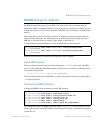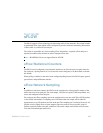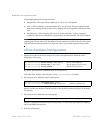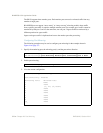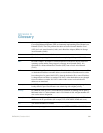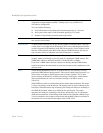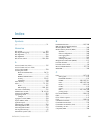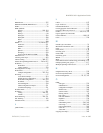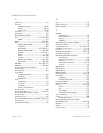
BLADEOS 6.5.2 Application Guide
382 Glossary BMD00220, October 2010
Tracking
In VRRP, a method to increase the priority of a virtual router and thus master
designation (with preemption enabled). Tracking can be very valuable in an
active/active configuration.
You can track the following:
Active IP interfaces on the Web switch (increments priority by 2 for each)
Active ports on the same VLAN (increments priority by 2 for each)
Number of virtual routers in master mode on the switch
VIR
Virtual Interface Router. A VRRP address is an IP interface address shared between
two or more virtual routers.
Virtual Router
A shared address between two devices utilizing VRRP, as defined in RFC 2338. One
virtual router is associated with an IP interface. This is one of the IP interfaces that the
switch is assigned. All IP interfaces on the G8124s must be in a VLAN. If there is more
than one VLAN defined on the Web switch, then the VRRP broadcasts will only be
sent out on the VLAN of which the associated IP interface is a member.
VRID
Virtual Router Identifier. In VRRP, a numeric ID is used by each virtual router to create
its MAC address and identify its peer for which it is sharing this VRRP address. The
VRRP MAC address as defined in the RFC is 00-00-5E-00-01-<VRID>.
If you have a VRRP address that two switches are sharing, then the VRID number
needs to be identical on both switches so each virtual router on each switch knows with
whom to share.
VRRP
Virtual Router Redundancy Protocol. A protocol that acts very similarly to Cisco's
proprietary HSRP address sharing protocol. The reason for both of these protocols is so
devices have a next hop or default gateway that is always available. Two or more
devices sharing an IP interface are either advertising or listening for advertisements.
These advertisements are sent via a broadcast message to an address such as
224.0.0.18.
With VRRP, one switch is considered the master and the other the backup. The master
is always advertising via the broadcasts. The backup switch is always listening for the
broadcasts. Should the master stop advertising, the backup will take over ownership of
the VRRP IP and MAC addresses as defined by the specification. The switch
announces this change in ownership to the devices around it by way of a Gratuitous
ARP, and advertisements. If the backup switch didn't do the Gratuitous ARP the Layer
2 devices attached to the switch would not know that the MAC address had moved in
the network. For a more detailed description, refer to RFC 2338.



